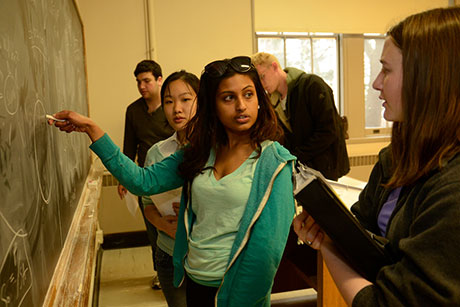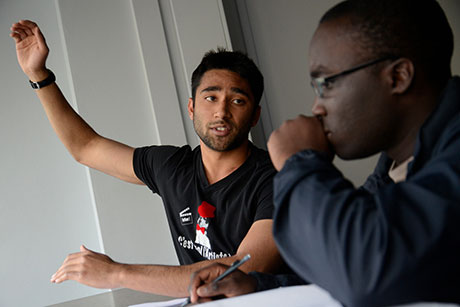Physics teacher training program going strong
By Anne Ju


A seven-year-old program that encourages undergraduate students to consider physics teaching careers and supports students in Cornell’s introductory physics courses has grown to over 60 participants this year, with no signs of slowing.
The Physics Undergraduate Teaching Assistant (UTA) program started with just eight students in 2007. It gives undergraduates teacher training through a seminar called Teaching and Learning Physics, taught by physics teacher-in-residence Jim Overhiser, of Owego Free Academy, and by placing them as teaching assistants in physics courses. UTAs receive course credit for both components.
A chief aim of the UTA program is to help alleviate a nationwide shortage of qualified high school physics teachers, and to give Cornell students the opportunity to explore that path. UTAs gain valuable teaching experience while considering careers not only as educators, but in educational administration, consulting, curriculum development and education research.
“There are a lot of interesting career paths in the roughly half-trillion dollar a year K-12 education sector of our economy,” said Professor of Physics Rob Thorne, who leads the program. “Cornell can have a significant impact, even if only a small fraction of our UTAs pursue careers in that sector.”
UTAs are partnered in their teaching assignments with traditional graduate teaching assistants, and they can teach in any of eight introductory physics courses targeting students across the sciences and engineering.
Teaching forces the UTAs to think about physics from the diverse perspectives of their students, Thorne said, helping them improve their own physics understanding and develop more expert problem-solving skills.
Nolan Machado '14 was a UTA and is now teaching physics at Weill Cornell Medical College in Qatar. He majored in economics and biology at Cornell, but discovered a love of physics sophomore year and went on to be a UTA in Physics 2207 and 2208 (Fundamentals of Physics I and II).
“I would find myself holding extra office hours, covering for TAs and staying up late with students just because I loved teaching,” Machado said.
A four-semester UTA, Karthy Chandra '15, a biological engineering major with a minor in business, also called the experience rewarding.
“I've learned a lot about teaching style and also a lot about physics, as I continued to learn and better understand concepts the more I taught them,” she said.
An integral part of the UTA experience is pairing each student with one of six high school teacher mentors. Throughout the year, UTAs are video recorded leading discussions, and the teacher offers critiques and guidance.
Dryden High School physics teacher Mike Mangini said he enjoys spending time with the Cornell students, who are “intelligent, bright young folks.”
“I think the interactions are mutually beneficial, and completely nonjudgmental,” Mangini said.
Deborah Lynn, an Ithaca High School physics teacher, also enjoys sharing teaching tips with the students. “Teaching is really hard,” Lynn said. “It's fun to talk about teaching and pedagogy, and it's really enjoyable to talk about those things with students who are thinking about possibly going in that direction, and helping them feel confident about what they're doing.”
Neither Mangini nor Lynn started out as teachers; Mangini was a geologist and Lynn a life sciences researcher. Thorne said he wants students to spend time with people like Lynn and Mangini to show that people come to teaching in different ways.
The UTA program has received support from Paul Walker '93 and Jennifer Wheary '92, and from the Department of Physics, after a seed grant from the American Physical Society ended in 2011.
Media Contact
Get Cornell news delivered right to your inbox.
Subscribe